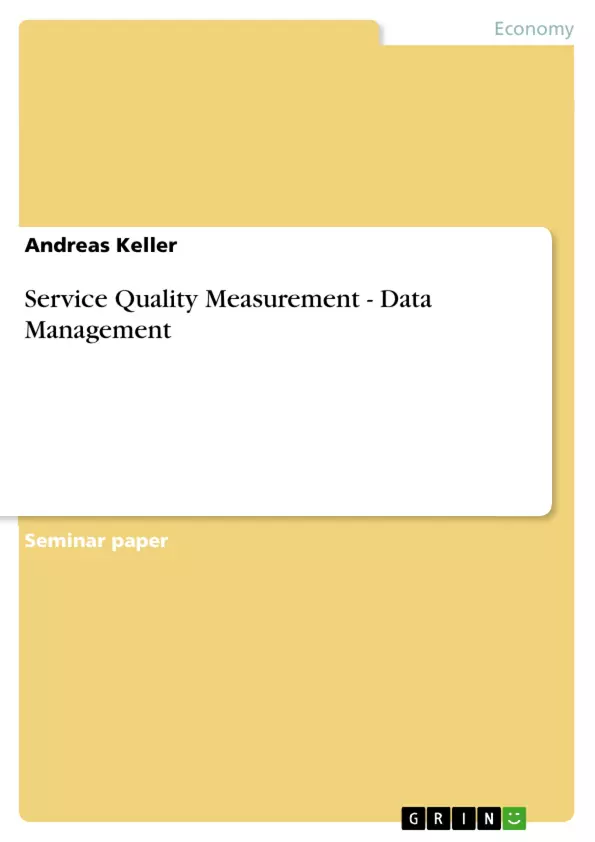Over the past decade Service Quality Measurement (SQM) has been receiving more attention worldwide and taking a more central role as a measurement of success. The notion of Service Quality is found well documented throughout the literature and describes the interactive process between the customer and the service provider. In general, the SQM is a powerful technique to monitor customer satisfaction, helping to focus on key areas of improvement in order to establish a new baseline to the current service quality rating.
The importance for service organisations is twofold: firstly, in the implications entailed in how to choose the most appropriate technique of service quality measurement, and secondly, in how service organisations can influence the perceptions of an individual customer/user in relation to the service encounter he/she is participating in. Empirically, this involves moving away from a standardised model of the same service for everybody to an approach where the best way of achieving excellent performance lies in addressing the subjective needs of an individual customer, providing precisely the specific service that reflects customers/ individuals’ perceptions.
In other words, service is not so much what the business does, per se, but what the customer experiences (Martin 1999i).
Inhaltsverzeichnis (Table of Contents)
- Abstract
- Introduction
- Part A - Questionnaire “Palavrion Corporation”
- Comments - Strengths & Weaknesses
- Probability Based Sampling Strategy
- Non-Probability Based Sampling Strategy
- Part B: Service Quality Satisfaction Survey - ADMECO AG
- Introduction
- Overview of ADMECO AG
- Problem Description & Objectives of Survey
- Definition of Population & Sampling Process
- Population
- Sampling; Consideration & Process
- Questionnaire Design
- Procedure & Guiding Principle
- Guiding Principle
- Design & Layout
- Pre-test the Questionnaire
- Result of Survey
- Response Rate
- Overview of Answers
- Personal Interaction - Analysis of Section 1
- Business Savvy - Analysis of Section 2
- Added Value - Analysis of Section 3
- Conclusion
- Introduction
- Part C: Middling Records - Data Analysis
- Introduction
- Presentation of Data
- Retrospective Analysis
- Model Validation
- Multiple R
- Correlation Coefficient (R2)
- Confidence Interval (CI)
- Outliers
- Model Validation
- Regression Model of CQSI - Forecasting 4th Quarter
- Comparison between Outlets - Impact on Sampling Strategy/Forecast
- Part D - Reflection
- Sampling Process/Questionnaire
- Data Analysis
- Appendices
- Palavrion Corporation Survey Form
- Service Quality Satisfaction Survey - ADMECO AG
- Middling Records Data Tables
- References
Zielsetzung und Themenschwerpunkte (Objectives and Key Themes)
This paper explores practical and theoretical approaches to data management in the context of service quality measurement. It examines the strengths and weaknesses of a customer satisfaction questionnaire, explores sampling strategies, and analyzes a service quality satisfaction survey and a data set related to customer satisfaction. The paper also includes a reflection on the learning points and insights gained from the assignment.
- Service Quality Measurement (SQM) and its importance in business success
- Customer satisfaction analysis as an integral part of business strategy
- Questionnaire design and its impact on data collection and analysis
- Sampling strategies and their influence on data reliability and representativeness
- Data analysis techniques and their application in forecasting and decision-making
Zusammenfassung der Kapitel (Chapter Summaries)
Part A of the paper analyzes a customer satisfaction questionnaire (CSQ) designed by Palavrion Corporation, a Canadian restaurant chain. The analysis focuses on the strengths and weaknesses of the questionnaire's design and discusses the applicability of probability-based and non-probability-based sampling strategies.
Part B examines a service quality satisfaction survey conducted at ADMECO AG, a Swiss company. The focus is on the questionnaire design, the sampling process, and the analysis of survey results.
Part C analyzes data from a survey conducted at Middling Records, a business with multiple outlets. The analysis includes model validation, regression analysis, and forecasting.
Part D offers a reflection on the key learning points and insights gained from the assignment, particularly concerning the sampling process, questionnaire design, and data analysis techniques.
Schlüsselwörter (Keywords)
Service quality measurement, customer satisfaction, questionnaire design, sampling strategies, data analysis, regression analysis, forecasting, business strategy, IT service provider, survey research.
- Citation du texte
- MBA Andreas Keller (Auteur), 2003, Service Quality Measurement - Data Management, Munich, GRIN Verlag, https://www.grin.com/document/178462



